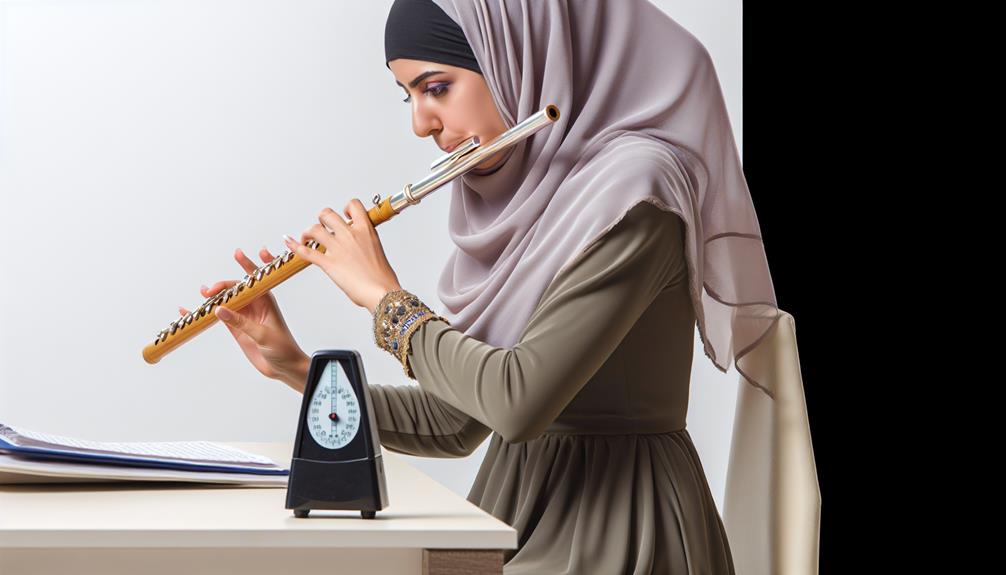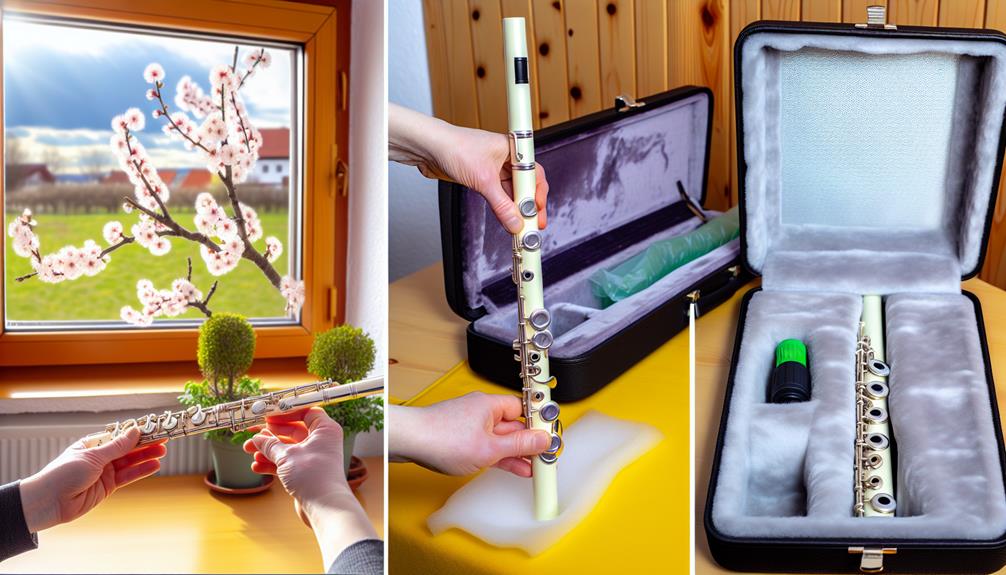When aiming to capture the true essence of a flute's melodic beauty through recording, attention to detail is key. From selecting the appropriate equipment to perfecting mic placement techniques, there are numerous factors to consider in achieving a pristine sound. However, beyond the technical aspects lie subtleties that can elevate a recording from good to exceptional. How does one navigate the realm of playing techniques, breath control nuances, and the art of expression to truly encapsulate the soulful resonance of the flute? Let's explore the intricacies that go beyond mere technical proficiency and delve into the realm of capturing emotive brilliance in flute recordings.
Key Takeaways
- Invest in high-quality microphones and audio interfaces for clarity and sensitivity.
- Experiment with microphone placement to capture the flute's full range and dynamics.
- Use pop filters to reduce unwanted noise and improve clarity in recordings.
- Consider room acoustics to enhance the overall sound quality.
- Focus on the flute player's technique for a clean and precise performance.
Selecting the Right Equipment
When embarking on the journey of flute recording, selecting the appropriate equipment is crucial to achieving optimal sound quality. The first step in this process is ensuring the quality of the equipment being used. Investing in high-quality microphones, audio interfaces, and headphones can make a significant difference in the final recording. Look for microphones specifically designed for recording wind instruments, as they are tailored to capture the nuances of flute playing.
Sound isolation is another key factor in the equipment selection process. To achieve a clean and professional flute recording, it is essential to minimize background noise and unwanted sound interference. Consider using a microphone isolation shield to reduce any echoes or external noise that could affect the recording quality. Additionally, using closed-back headphones can help the flutist monitor their playing without being distracted by external sounds.
When selecting equipment for flute recording, prioritize quality and reliability. Opt for reputable brands known for their audio recording equipment to ensure consistency and accuracy in capturing the flute's sound. By focusing on equipment quality and sound isolation, you can set a strong foundation for producing high-quality flute recordings that stand out for their clarity and precision.
Setting Up Your Recording Space
To optimize the recording quality of your flute sessions, meticulous attention to setting up your recording space is paramount. The environment in which you record can significantly impact the final sound quality of your flute recordings. Here are some essential steps to consider when setting up your recording space:
- Acoustic Treatment:
Ensure your recording space is acoustically treated to minimize unwanted reflections and reverberations. Use acoustic panels or foam to absorb sound waves and create a more controlled recording environment.
- Lighting Setup:
Proper lighting is crucial for creating a comfortable and visually appealing recording space. Ensure your recording area is well-lit to help you read music sheets or adjust equipment settings easily.
- Positioning of Equipment:
Place your recording equipment strategically to capture the best sound possible. Position microphones at the appropriate distance and angle from your flute to achieve a balanced sound.
- Minimize Background Noise:
Choose a quiet location for your recording space to minimize background noise interference. Consider soundproofing the room or using a noise gate to eliminate unwanted sounds.
- Comfortable Seating:
Set up a comfortable chair or stool in your recording space to ensure you can maintain good posture while playing the flute for extended periods.
Mic Placement Techniques
Strategically positioning microphones is essential to capture the nuances and intricacies of flute performance in recording sessions. When aiming to achieve optimal sound isolation and capture the true essence of the flute, one must consider room acoustics and mic placement techniques.
To begin, understanding the room acoustics is crucial. Identify the natural reverberation and acoustic properties of the room where you are recording. A room with too much reverb can muddy the sound, while a very dry room may result in a flat recording. Experiment with different locations within the room to find the sweet spot that complements the flute's sound.
When it comes to mic placement techniques, consider using a condenser microphone for its sensitivity in capturing the nuances of the flute. For a bright, clear sound, position the mic around 12-18 inches away from the flute, slightly off-axis from the player's mouth to avoid excessive breath noise. Additionally, using a pop filter can help reduce plosives and maintain a clean sound.
Experiment with different mic placements, such as trying a mid-side technique for a wider stereo image, or a close-mic setup for more intimate recordings. Remember, the goal is to find the perfect balance between capturing the flute's natural tone and minimizing unwanted room reflections.
Adjusting Levels and Settings
In the process of flute recording, precise adjustment of levels and settings is paramount to achieving a high-quality audio capture. When it comes to adjusting levels and settings for flute recording, there are several key factors to consider to ensure optimal sound quality and clarity.
Here are some essential tips to help you fine-tune your recording setup:
- Sound Proofing Techniques: Implement soundproofing measures in your recording space to minimize external noise interference, ensuring a clean recording free of distractions.
- Audio Compression: Utilize audio compression tools to balance the dynamic range of your flute recording, enhancing the overall sound quality and ensuring consistent levels throughout the performance.
- Room Acoustics: Take into account the acoustics of the room where you are recording. Experiment with different room setups and acoustic treatments to achieve the desired sound characteristics for your flute recording.
- Signal Processing: Explore various signal processing techniques such as equalization and reverb to enhance the tonal quality and spatial depth of your flute recording, adding a professional touch to the final audio output.
- Monitoring Levels: Continuously monitor and adjust input levels during recording to prevent clipping or distortion, ensuring a clean and distortion-free flute recording that captures all nuances of your performance.
Playing Techniques for Recording
Effective flute recording relies on mastering specific playing techniques that optimize audio capture quality. Breath control is a fundamental aspect when recording the flute. Maintaining steady and controlled airflow is crucial for producing a consistent sound quality. To ensure a clean recording, control your breath pressure to avoid unwanted variations in volume. Practice breathing techniques to support a stable sound throughout your recording session.
Vibrato techniques are another essential element to consider when recording the flute. Vibrato adds depth and richness to the sound, enhancing the overall musicality of your performance. When recording, be mindful of the speed and width of your vibrato to achieve the desired effect. Experiment with different vibrato styles to find the one that complements the piece you are recording.
It is important to strike a balance between breath control and vibrato techniques to achieve a well-rounded and professional flute recording. Practice integrating these techniques into your playing to enhance the expressiveness and clarity of your sound. By mastering these playing techniques, you can elevate the quality of your flute recordings and create captivating musical pieces that resonate with your audience.
Editing and Mixing Tips
Enhancing the final audio quality of a flute recording requires meticulous editing and skillful mixing techniques. When it comes to editing and mixing a flute recording, attention to detail is key. Here are some essential tips to help you achieve the best results:
- Post Production Techniques: Utilize post-production techniques such as noise reduction, audio restoration, and timing adjustments to enhance the overall quality of the recording.
- Sound Editing: Pay close attention to sound editing by cutting out any unwanted noise, adjusting levels, and ensuring a smooth transition between different sections of the recording.
- Audio Mastering: Engage in audio mastering to fine-tune the overall sound of the recording, ensuring that it is balanced, clear, and ready for distribution.
- EQ Adjustments: Make precise EQ adjustments to enhance the tonal quality of the flute, ensuring that it sits well in the mix without overpowering or getting lost.
- Mixing Techniques: Use advanced mixing techniques such as panning, reverb, and compression to create a sense of space and depth in the recording, making it more engaging for the listener.
Frequently Asked Questions
How Can I Reduce Background Noise in My Flute Recordings?
To reduce background noise in flute recordings, employ noise reduction techniques such as using a dedicated recording space with minimal environmental noise. Ensure the room is acoustically treated to minimize reflections and echoes.
Additionally, consider using a directional microphone placed close to the flute and away from noise sources. Experiment with microphone placement and settings to optimize sound capture while minimizing unwanted background noise for cleaner recordings.
What Software Is Best for Editing Flute Recordings?
When seeking the best software for editing flute recordings, consider programs like Adobe Audition, Pro Tools, or Logic Pro X.
These platforms offer a range of features to enhance your recordings, including advanced editing tools, plugins for noise reduction, and the ability to adjust settings for optimal sound quality.
Experiment with different recording techniques and settings to find the perfect combination that suits your flute playing style and desired sound outcome.
Are There Specific Microphone Brands Recommended for Flute Recording?
When considering microphone brands for flute recording, it is essential to prioritize those known for capturing the nuances of acoustic instruments. Brands like Neumann, AKG, and Sennheiser are often recommended for their clarity and accuracy.
Microphone placement plays a crucial role in capturing the flute's full range of tones, while considering room acoustics helps minimize unwanted reverberations.
Selecting high-quality microphones from reputable brands can significantly enhance the fidelity and richness of flute recordings.
How Can I Prevent Clipping or Distortion in My Recordings?
To prevent clipping or distortion in your recordings, carefully monitor your recording levels to ensure they do not exceed the maximum threshold. Utilize techniques such as adjusting microphone placement and gain settings to capture a clean signal without overloading.
Implement noise cancellation strategies like soundproofing your recording environment and using pop filters to reduce unwanted background noise.
What Are Some Tips for Maintaining Consistent Tone Throughout a Recording Session?
Maintaining focus and breath control are essential elements in ensuring a consistent tone throughout a recording session. By paying attention to your embouchure and airflow, you can maintain a steady sound quality across different pieces or takes.
Practice proper breathing techniques, relax your body to avoid tension, and stay mentally engaged with the music. These strategies will help you achieve a seamless and polished performance in your flute recordings.
Conclusion
In conclusion, by following these flute recording tips, you can ensure that you capture the best sound possible for your recordings.
Selecting the right equipment, setting up your recording space effectively, mastering mic placement techniques, adjusting levels and settings, and focusing on playing techniques will all contribute to a clean and precise performance.
Stay tuned for more in-depth insights and techniques to elevate your flute recordings to the next level.



